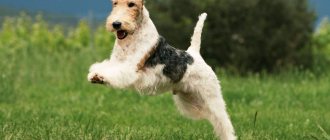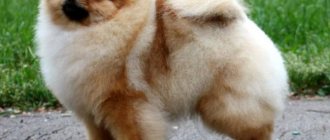Features and history of the rescue dog
A rescue dog must have a stable nervous system.
Dogs have been devoted to people since ancient times. Wild animals in those years were ready to serve their owners in exchange for warmth, care and affection. The animals followed the primitive hunters, trying to feast on the scraps that remained from the prey. By eating leftover food, the dog freed the environment from leftovers, which emitted an unpleasant aroma during rotting.
Tamed animals gradually acquired the appearance of modern domestic dogs, becoming more and more attached to humans. Animals became his loyal allies, and thanks to their intelligence and endurance they could help people in difficult situations. This is how the first four-legged friends appeared, who became rescue dogs.
Note! Ancient people successfully used dogs to hunt wild animals, to scare away enemies and to warm the owner with body heat on especially frosty winter days.
Gradually, the descendants of wolves learned to perform the functions of shepherds and guards. Faithful companions provided assistance to both farmers and cattle breeders. Trying to demonstrate his love to his owner, the dog often saved his life by rushing into battle with enemies, pulling a person out of a snowbank or from under the rubble of a collapsed building.
Loyal animals sensed danger at the level of intuition and could sense the smell of people even under a layer of snow 100-200 cm deep thanks to their well-developed sense of smell. The selection of the most capable specimens made it possible to develop breeds of rescuers who successfully found people during a natural disaster and protected people in extreme situations.
A rescue dog must meet the following requirements, namely:
- well-developed sense organs (ears, nose and eyes);
- determination;
- goodwill;
- good physical fitness and endurance;
- stable nervous system.
Rescue dogs must be easy to train and obedient.
Dogs in service in the Ministry of Emergency Situations
Canine services exist in every regional center; it is a branched structure of professional and volunteer teams. There are such well-known canine units as PSSC (Search and Rescue Canine Service) and Tsentrospas. Dogs undergo special selection through testing, which is carried out for puppies in the first three months of birth. Puppies that do not have a sufficient sense of smell or exhibit fear will not be accepted into rescue services. Upon completion of training, each animal passes an exam and is assigned to the Ministry of Emergency Situations that is optimally suited for its demonstrated qualities.
It is impossible to imagine how human history would have developed if we had not had a dog - a loyal, brave, intelligent and strong friend. For thousands of years they have guarded and protected, helped in hunting and transported goods. They are the ears and eyes of those who need it. And if trouble comes, rescue dogs do everything to save the life of a stranger at any cost. What are they, our four-legged guardian angels?
A small lump that is no more than three months old. He's such a fool: he chases his own tail, clumsily jumps on the sofa, constantly tries to kiss. But already at this age you can understand whether a funny puppy will be able to become a faithful, capable and strong rescue dog, whose life is closely intertwined with the lives of people who find themselves in a terrible situation - a situation where it is almost impossible to help yourself.
During the Second World War, after the bombing of London, the four-legged rescuer Irma found seventeen people in the ruins of buildings.
One day a stranger visits the house. He has kind eyes, a gentle voice, and he smells pleasantly of something subtly familiar. How interesting and fun! For some reason, the owner is worried and keeps saying that he really wants to become a volunteer, that he admires rescue dogs who work in the mountains, on fires, rubble and in many other places, the names of which do not yet mean anything to the puppy. The stranger tells the owner about some tests. I wonder if they are as tasty as the dough? It seems that the stranger is about to play: he touches his nose, teases with a bone, claps his hands, drops a rattle on the floor, runs away and hides, invites the owner to play.
St. Bernard Barry saved four dozen people during his twelve years of service. In total, throughout the history of the breed, St. Bernards have saved the lives of thousands of people.
Just like that, at the owner’s request, the journey of two heroes begins – a rescue dog and its owner. So far this is only a small step, and there are still two long years of training for the main teams, training in various conditions and testing for “professional suitability”. Of course, the fate of many puppies is determined even before birth if, for example, the baby’s parents work in the Ministry of Emergency Situations. But throughout history, rescue dogs working in tandem with their owners achieve very high results - either due to emotional attachment, or due to the amount of time the owner devotes to his pet.
Loyal to humans, representatives of the canine family by nature are called upon to serve their owners in exchange for their warmth, care and affection. This has been the case since the times when a wild animal, similar and about the size of a bird, relentlessly followed the primitive hunter to feast on scraps from his prey.
And as he received tidbits, he became more and more useful to him, clearing people’s homes of food debris, freeing the environment from the disgusting smell of rot.
The descendants of the tamed animal, becoming attached to their owners with each generation, gradually took on the appearance and acquired the features of modern dogs. Millennia have passed. Since then, previously wild dogs have proven themselves not only to be loyal allies, but also hardy, strong guardian angels. rescue dogs appeared
.
Using the four-legged servant, at first, to successfully hunt wild animals, the ancient people, seeking safety and comfort, over time found other uses for the domesticated animal. scared away uninvited guests, licked the owner's wounds and warmed him with the warmth of their bodies in severe frosts.
Later, representatives of human civilization became cattle breeders and farmers, but the descendants of wolves continued to live together and brought new benefits. And dogs were easily used, because they played the role of shepherds, guards and faithful companions.
In the photo there is a rescue dog of the German Shepherd breed
Small dogs are perfect for searching for people in rubble after earthquakes and during fires, as they have an excellent sense of smell and can crawl through even narrow crevices. They are hardy, efficient, and foreign odors are not a hindrance for them in searching for a target.
The best water rescue dogs
are rightfully considered to bear the well-deserved name “divers”. They are resistant to cold and feel great even in icy water.
The membranes between their paws and the structure of their ears and eyes allow them to swim tens of kilometers tirelessly and dive to great depths. They, without hesitation, rush into the water in the blink of an eye even at the slightest suspicion that a person is drowning.
In the photo there is a Newfoundland dog “diver”
The retriever is a very hardy dog, extremely smart, easy to train and obedient. Such dogs not only serve as rescuers, but also as guide dogs.
Labrador rescue dog
They specialize in searching for people in difficult conditions, helping in emergency situations. – service dogs and wonderful sappers. There are many other breeds with amazing rescue qualities.
Today, like many centuries ago, man and dog need each other. There are many known cases where rescuers saved a dog
, abandoned for various reasons and becoming an unnecessary burden for the owner.
And such dogs, in turn, successfully trained and carried out many years of dedicated service, bringing a variety of people back to life, becoming talented rescuers, receiving medals and awards.
Doberman rescue dog
Water rescuers
Below you can see the dog breeds that have become the best water rescuers.
Labrador retrievers are the first to work at disaster sites
Labrador Retriever
Since ancient times, Labradors have been used by fishermen to help their pets pull out fishing nets from the depths of the sea. In the 19th century, the dog was brought to Great Britain and crossed with the retriever, which has a curly coat. This is how the Labrador Retriever breed was developed. The height of the animals reaches 60 cm, and the weight is in the range of 38-40 kg. Dogs are friendly and patient.
The four-legged friends of this breed are easy to train. When training, you should give preference to the game format of classes. During training, various natural disaster scenarios are played out. Smart animals quickly realize what is required of them and easily overcome all obstacles. Retrievers often take part in rescuing victims during floods and earthquakes. Ice water does not frighten gentle dogs. They rush into the water, trying to help the drowning people as soon as possible.
Note! Labrador retrievers participating in water rescue operations can reach speeds of up to 5 km/h.
In order to prepare a dog for service in a water rescue unit, it is necessary to teach the pet the following skills:
- obeying commands in the water;
- towing a drifting boat;
- rescuing drowning people.
To help people who have begun to drown, animals must quickly swim up to the victims and give them the opportunity to grab onto the fur or harness. It is important that the dogs of the Ministry of Emergency Situations are healthy and physically strong, because performing rescue operations requires enormous physical exertion. It is necessary to begin training future Labrador rescue dogs at 2-3 months of age.
Newfoundland
Dogs that can be called divers lived on the island of Newfoundland. It was in honor of this island that the breed received its name. Four-legged friends are distinguished by their good-natured character and courage. Since ancient times, animals have helped fishermen pull heavy nets from the depths of the sea and pull drowning people out of the water. In order to take part in water rescue operations, pets must complete a training course. Finding himself in an extreme situation, a diver instantly analyzes the situation and makes an important decision to help save the victims.
The body height of a Newfoundland is between 68-70 cm, and the weight of an adult can exceed 65-70 kg. During training, it is important to show respect to the dog and be affectionate, because representatives of the breed are sensitive to changes in intonation. Shaggy giants do not freeze when in cold water, due to the fact that their coat is endowed with water-repellent properties. The interesting structure of the ears and the presence of a third eyelid allow dogs to completely immerse themselves in water and cover a considerable distance in a body of water.
Newfoundland without hesitation rushes into the water after noticing a drowning person
Leonberger
Representatives of the breed, which are among the best rescuers today, were bred in Germany. Heinrich Essig, by crossing several breeds, managed to create a large dog whose muzzle was painted black. These animals differ from other breeds in strength and endurance.
Dogs have acute hearing and excellent vision. Their significant advantage is the ability to swim well. In an emergency, the Leonberger will rush into the water without hesitation to save a drowning person. The height of the four-legged friend reaches 80 cm, and the weight can exceed 70-75 kg.
Representatives of the breed delight their owners:
- devotion;
- calm;
- mind;
- patient and good attitude towards small children.
When training your pet for water rescue work, you should not allow your voice to rise.
The Leonberger is considered a versatile dog that is highly trainable.
Rescuers in the mountains
Below you can find a description of the dog breeds that are recognized as the best rescuers of people in the mountains.
Saint Bernard
What dog works as a snow rescuer? Of course, this is a St. Bernard.
According to legend, in the Alps, on the harsh St. Bernard Pass, people often fell into snow traps. The air temperature in these places drops to -35 degrees in winter. A person could not survive for a long time in snowy confinement in the cold. That is why in the 15th century it was decided to build the Saint Bernard Shelter near the harsh pass. Travelers were able to stop at this place in order to gain strength and be able to get to the final point of the hike.
To save people who were covered by an avalanche, they began to use Alpine mastiffs, which soon began to be called in honor of the pass (St. Bernards). The height of adult individuals reaches 70 cm, and the weight is in the range of 88-92 kg.
Among the main advantages of the breed it is worth highlighting:
- devotion;
- endurance;
- lack of fear.
Note! Thanks to their impeccable sense of smell, four-legged friends of the St. Bernard breed are able to sense the approach of a cyclone 30-40 minutes before it starts.
A snow rescue dog goes in search of missing people in the mountains, looking for victims under a huge layer of snow. After the missing person is found, the dog will dig him up, pull him out of the snow and warm him with the warmth of his body.
Saint Bernards are considered the most fearless mountain rescuers.
German Shepherd
What dogs help rescue climbers? Most often, rescue operations are carried out with the participation of a German shepherd.
At the beginning of the 16th century, representatives of the German Shepherd breed were actively used as home guards and to protect their family members. Balanced and strong dogs that rescue people in the mountains have a keen sense of smell. Therefore, they are often recruited to serve in the Ministry of Emergency Situations in Russia, so that their four-legged friends help save people who disappeared in the mountains during an earthquake.
The German Shepherd is easy to teach new commands and skills. Dogs with a strong character endure long and frequent training, quickly remembering what the trainer wants from them. The height of adult males reaches 64-66 cm, and the weight does not exceed 40-42 kg. The character of dogs of this breed is kind and flexible, which allows the animals to get along not only with adults, but also with children and other animals living in the family.
German Shepherds are good at navigating their surroundings.
Belgian Shepherd (Malinois)
Belgian Shepherds were bred in the city of Mechelen in Belgium. Dr. Adolf Rühl worked on breeding the breed, who set himself the goal of obtaining a new variety of shepherd dogs. Selection work was carried out for 6 years, after which the Belgian Shepherd Club was founded. In the 19th century, the canine community recognized the standard of the new breed.
The height of adult Malinois dogs reaches 55-58 cm, and the weight rarely exceeds 28-30 kg. Belgians are used by people to rescue persons who are in trouble in mountainous areas. Agile pets are naturally endowed with:
- acute sense of smell;
- well-developed instinct;
- the ability to find a person in the snow.
Belgian Shepherd, a mountain rescue dog that quickly digs out an avalanche victim. Training a Malinois is not particularly difficult. The dog is able to concentrate attention on the trainer and clearly perform the required actions. Energetic, friendly, responsible and affectionate four-legged friends are able to protect family members and the home.
- In memory of St. Bernards...
- Sanitary dogs
- Search and rescue dogs
- Russian Rescue Dog Service
- Dogs predict
- Dogs reason
DOGS RESCUE, PREDICT, REASON...
In memory of St. Bernards...
To find victims of natural disasters who were buried and invisible on the surface, they have long resorted to the help of trained dogs. It has recently been established that in Central Asia, long before St. Bernards, rescue dogs were used for these purposes, but there is little detailed information about them. In the Pamir-Alai mountains near the Sandyk pass, a drawing of a dog saving a man was found on a rock. It is believed that the drawing, which is at least one and a half thousand years old, depicts the legendary rescue dog Ayas.
Powerful, hardy and good-natured Saint Bernards saved travelers near the Great Saint Bernard Pass in the area of the monastery of the same name, built in Switzerland in the 10th century.
Work on breeding this breed specifically to save people began in the 14th century. Judging by the description and stuffed Old Barry, kept to this day in the museum of the city of Bern, the St. Bernards of those times bore little resemblance to their descendants. In their constitution and behavior, they were more reminiscent of modern Central Asian and Caucasian shepherd dogs. Old Barry became the symbol of the rescue dog.
It is worth recalling that Old Barry alone saved 40 people during his 12 years of work. According to recent studies, St. Bernards saved not hundreds, but thousands of people during their service in the mountains. They found and rescued not only avalanches, but also those buried in snowfall, landslides, and lost in a blizzard. The dogs did this work completely independently. Having found the victim, they helped him regain consciousness and get to the shelter. If this failed, the dogs returned to the monastery, raised the alarm and brought people to the scene of the incident. There are several ancient images of Barry with the rescued child on his powerful back. Barrels of rum, as is often depicted in drawings of later times, were not worn around the neck by St. Bernards during their “working activities.”
Sanitary dogs
Medical dogs, designed to find and transport the wounded, have been used in the armies of many countries for a long time. During the Russo-Japanese War, dog sleds successfully transported the wounded from the battlefield. During the First World War, in a number of combat areas, dogs delivered medicine to the front lines.
In World War II, dogs were used in civil defense units in addition to these purposes. For example, only one ambulance dog named Irma saved 17 people in the ruins of destroyed buildings after the air bombing of London. In history there has never been such a massive and effective use of service dogs as during the Great Patriotic War in the Soviet Army. Four-legged workers are responsible for more than 600 thousand wounded soldiers taken from the battlefield.
Sanitary dogs, not afraid of shots and explosions, helped find the wounded on rough terrain, in smoke, fog and at night, when finding them in the usual way was impossible. Such dogs could thoroughly search the area, being at a considerable distance from their leader, find the wounded, notify about this and lead the orderlies along the shortest route. To alert the dog, a special stick (diarrhea-pointer) was hung from the dog’s collar, which it took into its mouth, returning to the counselor after finding the wounded person. These dogs worked in any weather, but found the victim only on the surface.
Search and rescue dogs
The history of the new use of dogs to find victims under the thickness of the rubble is as follows. During World War II, Swiss orderlies used German shepherds to find the wounded.
With the construction of a dense network of cable cars in the post-war years and the development of skiing, a huge wave of athletes and tourists poured into the mountains. The number of avalanche victims has increased markedly. It was then that the Swiss Alpine Club (SHAK) remembered the former glory of the St. Bernards and decided to use the sanitary dogs left after the war to search for people in avalanches.
The results were positive - after completing a special training course, the dogs saved more than 10 people in the first year. A few years later, SHAK already had a sufficient number of well-trained search dogs and guides.
Name of search and rescue dog
(PSS) is close to the name of the English association “Search and rescue dog association”: However, in England itself, mainly in Scotland, there is also another name -
avalanche dog,
which is also common in other European countries.
There are also such names for these dogs: search, rescue, protection,
etc. Unfortunately, there is still no single international name for dogs of this service, and, more importantly, there are no uniform standards for checking the level of professional training of the handler and dog, as well as their “clear place”, rights and responsibilities when working in an emergency zone.
The Swiss experience in search and rescue work with dogs, the organization of their training and division into classes was soon adopted by many countries with minor amendments to their geographical and other features. Currently, in all European countries, rescue services successfully use dogs, the number of which is constantly growing.
Russian Rescue Dog Service
All types of natural disasters occur across the vast territory of our country. According to the Problem Laboratory of Snow Avalanches and Mudflows at Moscow State University. Lomonosov, about 20% of its territory is avalanche dangerous due to the nature of the relief. Mudflow-prone areas occupy an even larger area.
In addition to increasing the concentration of people in inhabited mountainous areas (Caucasus, Khibiny, Ural), we, like no other country, are developing and settling new areas of Western and Eastern Siberia. They are visited by numerous scientific expeditions, survey parties, etc. Large construction projects are underway in the mountains, and thousands of tourists, climbers, and other athletes are constantly present. The need to strengthen the fight against all types of natural disasters is obvious.
In 1972, the USSR Mountaineering Federation decided to create a public Search and Rescue Dog Service (SPSS). To carry out this task, the Federation established a Commission for the Development of the SPSS, and in 1974, with the help of the USSR Service Dog Breeding Federation, the first training program for SPSS dogs was developed.
The Russian method of training PSS dogs has a number of advantages over the foreign one: we significantly speed up and facilitate the training of dogs by the fact that half of the training is carried out with burying not an extra, but only objects with its smell. The labor-intensive digging of a deep trench for it in dense snow or soil was replaced by burying the extra in any depression in the relief with the construction of a frame of poles over it, followed by backfilling, which significantly speeds up and facilitates the work. Our dogs not only find the victim, but also notify about this by barking and lead the guide to the location, which is very important at night, when visibility is poor. Our dogs find a person not only under the snow, but also under a layer of soil, in forest debris and other places. The use of medium-sized dogs (50–55 cm at the withers) makes it easier to maintain, transport and work in deep snow, ruins and rubble.
Dogs predict
The reason why PSS dogs are so widely used in many countries is simple. The probability of staying alive after two hours in the depths of the rubble is small, so the use of dogs not only saves time, but literally saves human lives.
The natural capabilities of a dog, the wealth of its psyche, are used by humans less than half. In an urbanized society, dogs serve mainly for entertainment and impressive canine exhibitions. The descendant of the “gray wolf” withers and degenerates in the hothouse conditions of the city and from idleness. How not to repeat the prophetic words of Saint-Exupery! “People have forgotten this truth... You are forever responsible for everyone you tamed.”
Dogs predict not only earthquakes, but also other natural disasters. More precisely, dogs, like other animals, feel and express this sensitivity through their unusual behavior. Their sensitivity to various natural phenomena exceeds that of humans, like their sense of smell, hundreds of times or more, which causes extreme surprise, misunderstanding and even distrust.
Here is what the famous English seismologist J. Abey says about this in scientific terms: “Predictions a day or more before earthquakes are explained by the fact that animals sense any pre-earthquake information from the earth’s surface that is beyond the range of human sensitivity”[1]. It should be added that when an alarm is raised by animals, foreshocks, that is, some of the subtlest precursors of an earthquake, are not recorded by seismic equipment. Of course, in addition to odor information, dogs, having a large range for high-frequency sounds, also receive sound information.
Let's look at several cases where dogs predicted natural disasters by their behavior.
Case 1.
In a Swiss mountain village, an avalanche buried five peasants. Immediately 2 border guards with a dog arrived at the scene. While the four soon discovered victims were being torn away, the dog, having independently examined a large area around, began tearing up the snow at a considerable distance. The fifth victim was quickly rescued from a depth of 1 m using avalanche shovels... Then something unusual happened. As if sensing the approaching danger, the dog curled up into a ball, raised its muzzle, laid back its ears and howled terribly. A few minutes after the rescuers and the victims left the avalanche escape, a second avalanche of even larger size came down from the slope, which would have buried everyone together.
Case 2.
The owner of the shepherd returned home late and did not go to bed. His wife was reading, his daughter was sleeping in the crib. Suddenly the dog rushed away, grabbed the girl by the shirt and rushed through the door. “This has never happened before... I’m furious,” thought the owner. He grabbed a gun and ran out into the street with his wife. At that moment, the house behind shook and collapsed. It shook, swayed, and the whole city began to collapse before our eyes. This is how the earthquake began in Ashgabat.
There are many similar examples of dog behavior. Since 1972, more than twenty natural disasters predicted by abnormal animal behavior have been registered in the domestic literature. There have been recorded cases of dogs and other animals “predicting” earthquakes in Armenia and Nefteyursk. A large number of such cases have been reported in recent years in Southeast Asian countries.
In dogs, there are several types of mental reactions before a disaster.
Type 1 - general excitement as a result of unclear anxiety. It is expressed in increased motor activity, howling, barking, etc. The 2nd type of reaction is purposeful behavior associated with the appearance of danger in an extreme environment. Animals flee from premises and leave their habitats. Dogs also have another type of behavior - overcoming fear, the instinct of self-preservation for the sake of saving the revered member of their clan, which dogs consider every good owner. In all cases, the dogs smelled, heard, sensed with some sense unknown to us the impending danger and displayed complex behavior, that is, they combined their instinctive behavior with pronounced rational activity.
The reasons that cause abnormal behavior of animals before the onset of natural disasters include: changes in magnetic fields, the emergence of infra- and ultrasonics of new parameters, the release of gases and odors from the earth’s crust that are not detected by humans and instruments, electrostatic charging of air aerosols, and others that are still poorly understood.
Dogs reason
“Nothing human is alien to animals,” Charles Darwin formulated what man has been thinking about since the time of Aristotle. Without going into controversy about what level of intelligent actions (which is very different for each individual) dogs are capable of, let us take as a basis the definition of Academician L.V. Krushinsky, also a good hunter and dog connoisseur.
By the ability of animals to reason or think, called in science “elementary rational activity” (ERA), we will understand “the performance by an animal in a new environment of a purposeful behavioral act, carried out on the basis of capturing the empirical laws of the environment” [2].
Raising the alarm by barking and squealing is also instinctive behavior. But when a dog, overcoming fear and the instinct of self-preservation, takes action to save its owner, the ERD turns on. The very affection, love and care for the owner include an element of rational activity, since it is not developed on reflexes reinforced by the provision of food and a warm corner. In the extreme situation of an earthquake, the ERD, “dormant” in everyday life, manifests itself vividly and is accompanied by appropriate behavior and action.
There are no methodological developments on how to develop in classes and use the ERD of a dog in difficult emergency conditions. One can only wish that every handler from the first steps of training with a dog would not only know about this, but would be able to use the rich possibilities of its higher nervous activity, remembering that all work is carried out on the basis of three components: instincts, learning ability and reason. In everyday life, the behavior of dogs and other animals is a complex of all these components.
Notes:
1
Here and below, see the source of the quotation in the list of references (pp. 141–142) under the corresponding number. — Note. ed.
2
Mazover A.P. Constitutional features of dogs // Hunting and hunting management, 1989. No. 11.
Table of contents
Rescue dog training
Rescue dog training should begin as early as possible. As soon as the puppy reaches 3-3.5 months, you can begin to master the initial skills of rescue work. Gradually, the training will become more serious and complex. However, before you start teaching your pet the first rescue skills, it is recommended that from 2 months of age you take a general training course, which will allow your baby to clearly assimilate commands, obey and follow simple instructions. During training, there is no need to raise your voice at the puppy, much less hit him, because it is during this period that mutual understanding is built between the dog and its owner.
Malinois, despite its modest size, is capable of helping people in trouble
Note! Constant training will allow you to raise a rescue dog that can help people in trouble.
As soon as the basics of the general training course have been completed, you can begin to teach the dog the specifics of search activity. Gradually, the commands become more complex and the dog is required to understand and follow commands even in the presence of a strong irritant, so that the future rescuer can do his job despite the distraction. At the end of the training course, the pet undergoes the highest intellectual education of a dog, during which the four-legged friend will learn to make decisions independently in an unusual situation when victims need urgent help.
What can a rescue dog do?
Rescue dogs are able to search for missing people and save them in critical situations. A service dog searches large areas in a short period of time and moves over rough terrain, not paying attention to pitch darkness and bad weather conditions. People are searched for:
- on the rubble;
- on dams;
- in the place of earthquakes and natural disasters, etc.
A rescue dog can search for victims without a leash or collar. The specialist only supplies the animal with a special device (the puppy must also have a chip). The pet is not afraid of the stench of gas, fire and acrid smoke. Brave heroes move independently and make decisions quickly. They can work, rescuing victims, both in the sultry heat and in the cold season.
Most rescue breeds were bred to help rescuers find and protect people in emergency situations. Four-legged rescue friends are naturally endowed with keen hearing, courage and excellent intuition. Reliable dogs will always come to the rescue and will not leave you in trouble.
Dog professions and specializations
Canine professions and specializations have evolved with progress. People needed help in a variety of industries, so new breeds and dog disciplines developed in all countries.
Today, dog specializations are divided as follows:
- Hunters and hunting dogs: Hounds and huskies, pointers (gundogs), greyhounds, burrowing dogs.
- Shepherds.
- Protective guard service.
- Guard service.
- Search service.
- Guide.
- Sled dogs.
A rescue dog, regardless of the industry in which it is employed, must have a number of qualities. The breed does not really matter, the main thing is that the dog has the following qualities:
- Stable psyche.
- Endurance and dedication.
- People-oriented.
- Ability to make decisions independently.
- Unquestioning obedience.
In many countries, rescue services employ medium-sized mongrel dogs. Quite often, breeds of other socialization are trained in social work.
Recently, Jack Russell terriers, active burrowing dogs, are often used as observation dogs for children with heart failure.











